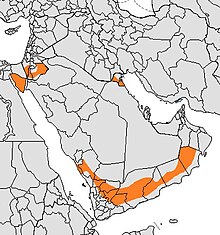Arabian wolf
| Arabian wolf Arabic: ذئب عربي | |
|---|---|
| File:52416658817761o022405fd0fiyyu.jpg | |
| Scientific classification | |
| Kingdom: | |
| Phylum: | |
| Class: | |
| Order: | |
| Family: | |
| Genus: | |
| Species: | |
| Subspecies: | C. l. arabs
|
| Trinomial name | |
| Canis lupus arabs | |

| |
| Arabian wolf range | |
The Arabian wolf (Canis lupus arabs) is a subspecies of gray wolf which was once found throughout the Arabian Peninsula, but now only lives in small pockets in southern Israel, southern and western Iraq, Oman, Yemen, Jordan, Saudi Arabia, and probably some parts of the Sinai Peninsula in Egypt.
Features and adaptations
The Arabian wolf is a small, desert-adapted wolf that stands at around 26 inches shoulder height and weighs an average of 40 pounds. Their ears are proportionally larger in relation to body size when compared to other species, an adaptation needed to disperse body heat. Arabian wolves do not usually live in large packs, and instead hunt in pairs or in groups of about three or four animals. However, footage of a pack 12 members strong was filmed for the BBC documentary Wild Arabia in 2013.{BBC Two - Wild Arabia Episode 2 The Jewel of Arabia} This subspecies is unusual, as it is not known to howl.[3] Arabian wolves have short, thin fur in summer, though the hair on their backs remains long even in summer. This is thought to be an adaptation against solar radiation. The winter coat is long, though not as long as northern subspecies. The Arabian wolf possesses no sweat glands; like other canines, it controls body temperature by rapid panting which causes evaporation from the lungs.[4] Unlike other grey wolves, the middle two toes of an Arabian wolf's paws are fused, a trait originally thought unique to the African wild dog.[5] It is distinguished from the Indian wolf by its paler fur, smaller size, and proportionally smaller head.[6]
Diet

Arabian wolves can attack and eat any domestic animals up to the size of a goat. As a result, farmers will not hesitate to shoot, poison, or trap them. Arabian wolves also feed on hares, rodents, ungulates, and any carrion they can find.
Arabian wolves hunt small to medium-sized animals such as cape hares, Dorcas gazelles, and ibexes, though they feed on carrion and livestock when in the vicinity of human settlements.[7]
Current status
It is listed as Endangered by the IUCN. In Oman, the wolf population has increased significantly since hunting was banned, and they probably will naturally re-establish themselves in certain places within the region in the relatively near term. In Israel, between 100 and 150 Arabian wolves are found all over the Negev and the Arava. In Iraq, wolves are causing a real problem to villagers and farmers since their numbers are increasing and more commonly seen in villages and rural areas. http://articles.latimes.com/2008/mar/17/world/fg-wolves17
In culture
The wolf was frequently mentioned in the Scriptures as an enemy to flocks (Sirach 13:21; Matthew 7:15), and an emblem of treachery and ferocity, and bloodthirstiness. The tribe of Benjamin, owing to its warlike character, was often compared to a wolf in the Old and New Testaments of the Bible.
References
- ^ Cite error: The named reference
iucnwas invoked but never defined (see the help page). - ^ "Canis lupus arabs". Integrated Taxonomic Information System. Retrieved 27 October 2007.
- ^ Lopez, Barry (1978). Of wolves and men. p. 320. ISBN 0-7432-4936-4.
- ^ Harrington, Fred H. and Paquet, Paul C. (1982). Wolves of the World: Perspectives of Behavior, Ecology, and Conservation. p. 474. ISBN 0-8155-0905-7.
{{cite book}}: CS1 maint: multiple names: authors list (link) - ^ Macdonald, David (1992). The Velvet Claw. p. 256. ISBN 0-563-20844-9.
- ^ Bright, Michael (2006). Beasts of the Field: The Revealing Natural History of Animals in the Bible. p. 346. ISBN 1-86105-831-4.
- ^ Hefner, Reuven; Geffen, Eli (1999). "Group Size and Home Range of the Arabian Wolf (Canis lupus) in Southern Israel". Journal of Mammalogy. 80 (2): 611–619. doi:10.2307/1383305. JSTOR 1383305.

